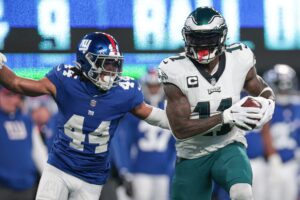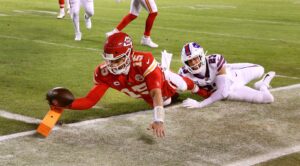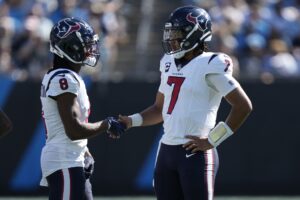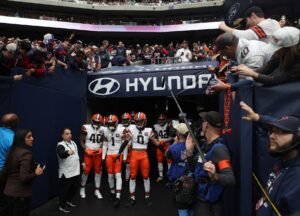In his 1972 novel Semi-Tough, the late Dan Jenkins imagines a version of the New York Giants that are no longer owned by the Mara family. Billy Clyde Puckett, the star running back of the G-Men, takes us with him through the week leading up to their Super Bowl appearance against the New York Jets. He introduces us to a slew of fictional misfits (his best friends), as well as his team… including a quarterback whose last name is Manning? Hmm…
Clearly, the book was far ahead of its time on many accounts. And while it is a work of fiction, it also presents a semi-accurate portrayal of American football in the late 1960s and early ‘70s. Puckett uses the phrase “semi-” as a prefix not meaning “partly,” but “majorly,” which, by the end of the tale, shows an attempted humility in the midst of the crass satire. As our narrator and his team prepare for their championship matchup on the west coast, they navigate adoring fans, their “dog-ass” rivals, women, and parties, as well as their new ownership, the ad agency DDD and F, which has taken over after the new Commissioner has foiled the Mara family’s plan to move the team to Bermuda.
While the world of the novel is plausible as a whole, it’s hard to imagine a Giants team without the Maras at the helm, a football world without the semi-brilliance that the Maras gifted to the league, or the semi-greatness that has graced the sports media landscape as semi-inspirations of the Maras and their work.
How the Mara Family Has Shaped American Football as We Know It
The First Giants Playbook
In 1925, New York City’s Tim Mara bought the New York Football Giants for a hefty sum: $500. The bookie left school at age 13 to enter the workforce and support his mother. He established himself in that trade by the age of 18 (one of his regular clients was Art Rooney, future owner of the Pittsburgh Steelers). He knew little about football, as sports were largely dominated by baseball and boxing at the time. But that $500 (for comparison, just over seven grand these days), became a franchise that is today worth about $3.3 billion.
In the beginning, it shouldn’t have been so problematic that the team was receiving no media coverage. They sucked. Regardless, the papers were flooded with news of the World Series between the Washington Senators and Pittsburgh Pirates, but no New York Giants were spoken of.
By 1930, professional football was still of questionable quality, but the team paired with Knute Rockne’s Notre Dame All Stars to play for charity at the old Polo Grounds, in an attempt to establish a superior reputation. While the Fighting Irish walked into an assumed easy win, they left without scoring a single touchdown. Rockne said of the Giants, “That was the greatest football machine I ever saw.” It was the last game Rockne coached before he was killed in a plane crash in 1931, and at the end of this season, Tim Mara transferred the team to his sons; Jack, who managed the business side of the team, and Wellington, who was put in charge of on-field operations.
The sons were initially given the deeds for the sake of insulating the team from creditors after the stock market crashed in 1929, but by 1946, they held full control.
Tim Mara’s Sons
Jack began his Giants career as a sideline yard marker from their inception. He graduated from Fordham University in 1930 with a degree in law, but ultimately never practiced after being given his new role as Vice President of the Giants. He was promoted to President in 1941.
Wellington began working for the team as a ball boy since its creation in 1925. He also graduated from Fordham, and took office as team treasurer and assistant to his father. He became the team’s secretary in 1940, before leaving for World War II, along with many of the players, in 1943, where he served as a Lieutenant Commander in the U.S. Navy.
Despite initial financial struggles league-wide, the Giants led the NFL in attendance on multiple occasions throughout the ‘30s and ‘40s. Wellington returned from the war in 1946 as Vice President under his brother’s leadership, and took over as President when Jack passed away from cancer in 1965.
By the ‘60s, the Giants were a leading attraction within the league. While that might have been capitalized on with higher television revenue, the Mara brothers argued in favor of equal revenue sharing amongst the entire league – today’s upheld practice. In 1966, the NFL absorbed the AFL, taking out the competition and strengthening the league even further.
Beyond the Mara Family
At the time of Semi-Tough, Wellington was in control of the crew. But as the franchise brand grew, so did the need for more distribution of responsibilities; a predicament that might be solved by Jenkins’ fictionalized corporate ownership. Up until 1974, Wellington had personally handled all football decisions, but now had a family of 11 children to support. But he figured it out. He turned over most of his day-to-day to Andy Robustelli, former championship-winning Giants and Los Angeles Rams Defensive End, who became director of operations, essentially acting as a general manager without the title. Five years later, Mara fully relinquished the football, appointing George Young as the team’s first official General Manager: the one who drafted Phil Simms and Lawrence Taylor, and selected Bill Parcells as head coach.
In 1990, Father Donald Monan called Wellington about interviewing assistant coach Tom Coughlin to become the head coach of Boston College. Wellington agreed to let Coughlin walk, but only if Monan agreed to take his youngest daughter, Colleen, as well. Later, Coughlin would return to the Giants as Head Coach from 2004-2015.
After Jack’s passing, his son Timothy inherited his father’s share of the Giants, and notably feuded with Wellington (a partition was built in the owners’ box to separate the two). Tim is credited for the Giants’ move to New Jersey from Yankee Stadium. But through his battle with cancer, the prodigal son sold his half of the team to former Bob Tisch in 1991 for $80 million. This was the first time in history that the team was not owned exclusively by the Mara family; a decision that likely saved the franchise.
Meet the Tisch’s
Preston Robert Tisch, the donor behind NYU’s Tisch School of the Arts, brought in another family to share in the Giants’ legacy. The Loews businessman had wrapped his stint as Postmaster General under the Reagan administration just three years before purchasing his half of the Giants, ending what many fans refer to as “The Dark Years.”
Wellington’s son John joined the Giants in 1988 as General Counsel, and later as Executive Vice President and Chief Operating Officer until his father’s death in 2005, when he assumed the role of President. Bob Tisch died the same year, and passed his share on to his son Steve, a film producer responsible for such successes as Forrest Gump and Risky Business.
Under Wellington Mara, the Giants won Super Bowls XXI and XXV, the latter with the Tisch patriarch.
Under John Mara and Steve Tisch, the Giants have so far won Super Bowls XLII and XLVI.
Keeping up with the Rooneys
In 1981, Wellington’s fourth-born Chris Mara married Kathleen Rooney; granddaughter of Art Rooney. As a result, Kathleen has more Super Bowl rings than any other person on the planet, living or dead; six from the Steelers, four from the Giants. The couple has four children: including two daughters Kate and Patricia (Rooney).
Yes, that’s right. Kate Mara and Rooney Mara, the actresses, are the great-grandchildren of both the Tim Mara family and Art Rooney family, so one can imagine they drew on their sports bloodlines for projects like We Are Marshall, The Winning Season, and Entourage. They may not be of the Tisch descent, but share football and Hollywood with that side of their first family franchise.
Behind Every Great Man
Perhaps the Mara sisters will see their sports and cinematic interests intersect in the future, when the movie honoring their late grandmother is made. In 2015, Ann Mara, Wellington’s widow and the “First Lady of Football” passed away after complications resulting from a fall during an ice storm. The Giants matriarch was known for her sense of humor and outspoken love for her team. In a legacy that has been largely led by the Mara men, Ann was said to have been the leader of the family for the past two generations. As part owner of the Giants organization, her legacy is just as fierce as that of the men with whom she shared it.
The Halas-McCaskey family of the Chicago Bears is the only ownership represented solely by a woman. It is also the only other franchise in the NFL that has been controlled by one family longer than the Giants.
These will not be the last franchise histories that prominently feature the matriarch behind great men. We have yet to see in action the five daughters and two sons of recently deceased Pat Bowlen, as they take over the ownership of the Denver Broncos, however that may play out. And, of course, should the Mara family legacy continue, it is bound to do so through one or more of John’s four daughters, as only son John Jr. has actively pursued a career in the theatre since 2010.
It Semi-Holds Up
Semi-Tough is not an easy read in the year 2019. The way that racial relations (well, actually, non-white races as a whole) are discussed makes for an interesting conversation about how racially-driven issues that currently litter the league are informed. The language Jenkins puts in the mouth of his narrator regarding women is highly questionable and explicitly raunchy. And many of the jokes have become dated.
Most fascinating, however, is Jenkins’ idea of putting ownership in the hands of a company; a decision made by the character Commissioner Cameron much to the pleasure of the fictional Giants team. The motivation behind the approval of the Maras’ sale to the DDD and F agency was to keep the team in New York. While the real Maras likely never would have considered moving their club, if they had, it is highly unlikely that the way to stop that from happening would be by selling the team to a corporation. To this day, the only publicly-owned NFL franchise is the Green Bay Packers, who created their own nonprofit to conglomerate their 360,760-sum owners (called Green Bay Packers, Inc.) in 1925.
Jenkins’ decision to go this route with his story did not result in any particular positive or negative perspective, but it would have been interesting to see how it might have. The picture he paints of the franchise isn’t palpably affected by corporate ownership, beyond the new head coach, who no one seems to be a fan of. But one can imagine that kind of reality with almost any given team.
But not with the Giants. It is hard to imagine one of the most beloved family clubs in history without the Maras at the helm, and thankfully, we haven’t had to yet.
Main photo:
Embed from Getty Images






